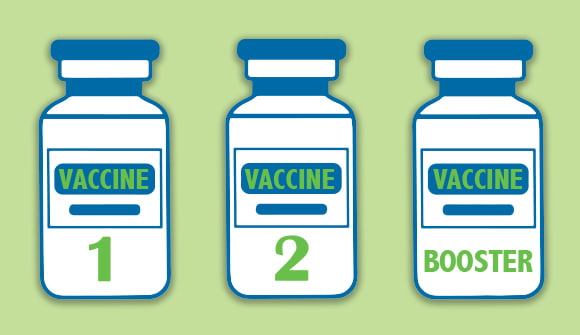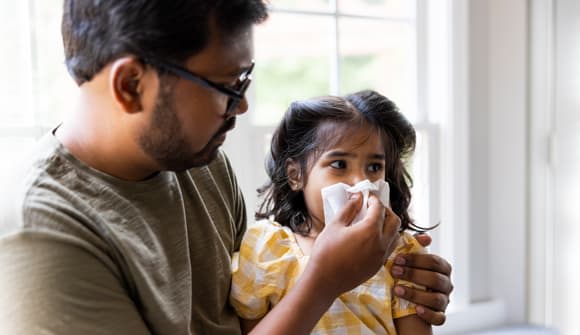My kid won’t wear a mask
5 tips to help children struggling with facial coverings.
Article Author: Katie McPherson
Article Date:

Is your kiddo going back to school in-person in the new year? If your child has been distance learning at home during COVID-19, he or she may not be used to getting dressed and putting on shoes each morning, let alone wearing a mask all day! But keeping a mask on while in the classroom will help your child, his or her classmates, and the teachers stay safe.
Daniel Thimann, MD, FAAP, board-certified pediatric emergency medicine specialist at Wolfson Children’s Hospital, sees children of all ages in the hospital each day. Some of his patients are totally fine with wearing masks, while others aren’t. He encourages all children and parents he encounters to take precautions.
“The American Academy of Pediatrics (AAP) recommends face masks of some sort for kids age 2 and older. We know that’s going to help protect your child from getting the coronavirus and decrease the odds of spreading it to others,” said Dr. Thimann. “That being said, you may try your best to keep your kid’s mask on his or her face, but sometimes you just can’t. It’s hard to break the will of a child.”
What should you do about those sometimes-stubborn kids who just can’t seem to keep their masks on? Consider these expert tips from Dr. Thimann and Jorge A. Diaz, MD, child and adolescent psychiatrist with Baptist Behavioral Health and Wolfson Children’s Hospital.
1. Start by making fun masks together.
Something Dr. Thimann learned from Wolfson Children’s Hospital’s Child Life specialists is that when kids get to decorate their own disposable masks, they are more excited to wear them.
“They can add stickers, like Pokémon or Disney characters,” he said. “It’s a lot easier to get them to do something if they feel involved.”
2. Choose reusable masks in designs kids will love.
If you’re working on getting your child to wear a cloth face mask, Dr. Diaz recommends trying to find one that feels comfortable and features a cool design they’ll love.
“Hear their concerns and feelings about having to wear a mask due to COVID-19 and be empathetic. At the same time, choose something they feel proud to wear, like a mask with their favorite sports team logo, superhero, or character. You can also play with your child and pretend his or her dolls or stuffed animals are wearing masks, too.”
3. Set a good example.
Monkey see, monkey do, right? If you want your child to accept longer periods of masking, it can be helpful to practice at home — together. Reinforce your practice sessions with some reminders to your child that he or she is being kind to others by wearing a mask.
“It is important as a parent to not complain in front of children about having to wear a mask,” Dr. Diaz said. “Be sure your child sees you wearing the mask properly covering your nose and mouth. In general, make your little one feel wearing a mask is normal. Practice wearing the mask at home. Then, give him or her the message that wearing a mask can save both their life and other people’s lives. It is all about compassion and kindness.”
4. If at first you don’t succeed, try again.
Just like grown-ups, kids will have different opinions on which kinds of masks they find comfortable. If they won’t stop yanking at one style, try others until you land on the right fit. Dr. Diaz said this can take time, especially for children with sensory difficulties.
“Try different masks that fall under the Centers for Disease Control and Prevention (CDC) recommendations. Pack extra masks for school in case teachers think your child is uncomfortable,” he said. “For children with conditions which may cause sensory sensitivity, like autism spectrum disorder and sensory processing disorder, it’s important to try different masks and remember these children might not only be bothered by the texture of the material, but the smell of the material also. Practice breathing slowly while wearing the mask and make sure they are adapting well to this new experience.”
5. Stay up-to-date on mask recommendations.
As more discoveries are made about the coronavirus and COVID-19, the guidelines on what kinds of masks are best for every age group can change. For example, masks with ventilation valves and neck gaiters have been found to be less effective than other mask types. Stay on top of any changes via the CDC website.
“It is recommended to be frequently checking for updates from the CDC or your doctors about wearing masks and COVID-19 in general,” said Dr. Diaz. “Consider contacting your primary care physician or pediatrician for any questions, especially if your child has a medical disability or condition that can compromise his or her ability to breathe.”
For more information and answers to frequently asked questions, visit baptistjax.com/covid-19 or wolfsonchildrens.com/covid19.
References: Updated CDC mask recommendations



